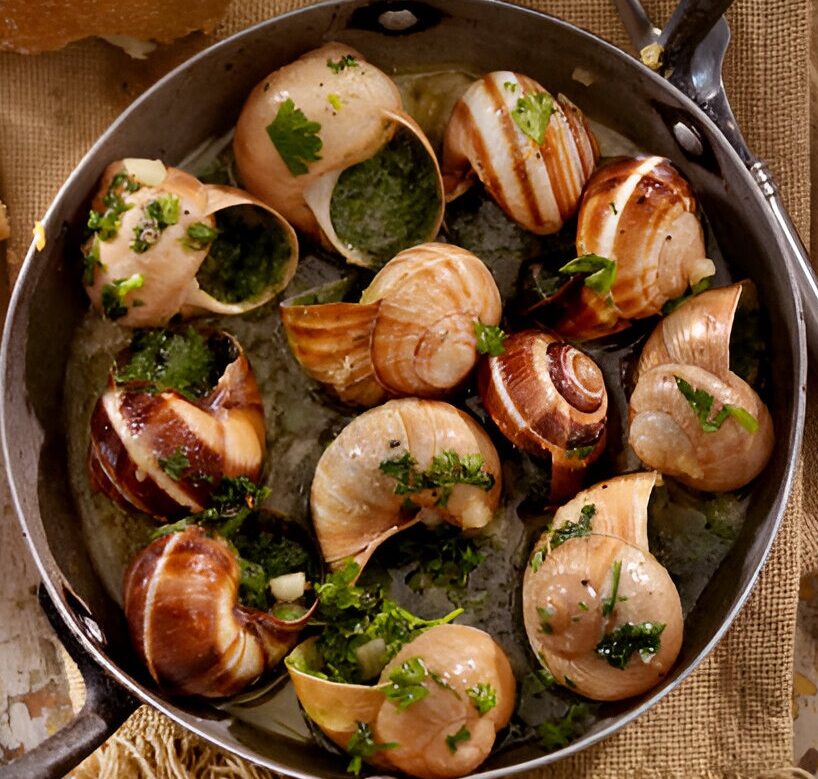Escargot, or snails prepared as food, is among the most famous—and possibly frightening—dishes in French cooking. Although eating snails may appear unappealing at first, when prepared properly, escargot is a rich, savory, and opulent experience.
For decades, it has been a mainstay of French cuisine, valued for its delicate texture and capacity to absorb the aromas of wine, herbs, and thick garlic butter.
Ingredients
8 oz unsalted butter, at room temperature
1 bunch flat-leaf parsley, finely chopped
1 garlic head
1 shallot, finely chopped
1 dash of nutmeg
2 tsp caper brine
1 tsp champagne vinegar
12 large escargot (fresh or canned), rinsed
Salt and pepper to taste
French bread for serving
Escargot Recipe
Step 1: Roast the Garlic
To give this recipe a richer, sweeter flavor, roasting the garlic is a necessary step. Set your oven’s temperature to 400°F (200°C) to begin. Cut off the top of the garlic bulb, then sprinkle it with a little salt and olive oil. After wrapping it in aluminum foil, roast it for around sixty minutes. By the end, the cloves should be tender and caramelized. In the finished meal, the nutty, somewhat sweet flavor of the roasted garlic counterbalances the richness of the butter.
Step 2: Make the Herb Butter with Garlic.
You can start making the herb butter while the garlic roasts. Combine the melted butter, finely chopped parsley, shallots, nutmeg, caper brine, and champagne vinegar in a food processor or by hand. Squeeze the roasted garlic cloves into the butter mixture after they have cooled down enough to handle. The escargot will be coated with this garlic butter, so taste it and add salt and pepper to suit.
Prepare the Escargot in Step Three
The snails and their sauce are customarily served in specialized escargot dishes, each of which has a tiny compartment. You can use a little muffin tin if you don’t have an escargot dish. Start by filling each compartment with a tiny bit of the prepared garlic butter. Place a snail inside each, then cover with a good amount of more garlic butter. Butter is essential to this recipe, so don’t cut it.
Bake the Escargot in Step Four
Set the oven temperature to 425°F (220°C). After preparing the escargot, bake it for ten to twelve minutes. The snails should be thoroughly heated and the butter should be sizzling. You can add a little crunch to the butter by briefly placing the dish under the broiler for one to two minutes, but watch carefully to avoid burning.
Step 5: Offer Escargot should be served hot, just out of the oven, right away. It is recommended to enjoy the buttery sauce with pieces of crispy French bread. In addition to helping lap up every bit of the delicious butter, the bread gives the soft snails a nice tactile contrast.
See also: Tomato Pastina
Tips and Variations
Roasting the Garlic: Although the flavor will be stronger, you can use raw minced garlic in place of roasted garlic if you’re short on time. Roasting adds richness and is highly recommended.
Escargot Dishes: Although escargot dishes are customary and aid in keeping the butter in place, you may just use muffin tins or ramekins, which are both oven-safe.
Alternatives to Herbs: The traditional option is parsley, but don’t be scared to try different herbs. Depending on your tastes, fresh tarragon, chervil, or thyme might give the dish a new complexity.
Wine Pairing: Serve the meal with a crisp, dry white wine, such as Chablis or Sauvignon Blanc, to balance its richness.
Why Escargot Is Worth Trying
The sensation of eating escargot is just as important as the taste. The smooth and creamy garlic herb butter contrasts wonderfully with the snails’ delicate, slightly chewy texture. In most preparations, crusty French bread is used to absorb up the butter that has been used to wash the snails. Escargot is a dish that is much more than the sum of its parts because of the butter’s rich and luxurious flavor, which is counterbalanced by the crisp freshness of herbs like parsley and the faint zing of champagne vinegar.
Beyond the tastes, however, preparing escargot at home ties you to centuries of culinary heritage. For hundreds of years, the meal has been served at upscale French dining establishments and lavish feasts. By making it yourself, you’re joining a long tradition of home cooks and chefs who have transformed ordinary ingredients into something remarkable.
Main Ingredients
Escargot: You can use canned or fresh snails. When prepared carefully, canned escargot still makes a delicious entrée and is more accessible. Before cooking, make sure to give them a thorough rinsing.
Butter: The foundation of the garlic sauce, butter gives the food a rich, creamy texture. To manage the seasoning, use unsalted butter.
Garlic: In contrast to the sharpness of raw garlic, roasted garlic gives the meal a pleasant, mellow richness.
Parsley: This herb lightens the thick butter sauce with its bright, fresh flavor.
Shallots: A softer substitute for onions, shallots offer a delicate sweetness and nuance.
Champagne vinegar: The richness of the butter is counterbalanced by a little acidity.
Nutmeg and caper brine are delicate additions that give the meal a mild spice and an additional depth of flavor.
Final Thoughts
Although making escargot at home could seem like a challenging culinary task, when broken down step-by-step, it’s really simple. This dish honors the opulent simplicity of traditional French cooking while also demythologizing the procedure. You can impress your guests and develop your culinary talents by perfecting the roasted garlic butter and pairing it with soft snails.
Escargot is a delicacy that brings centuries of tradition to your table, so don’t be scared to try it. Escargot becomes a memorable meal when served with fresh bread and a nice glass of wine.

